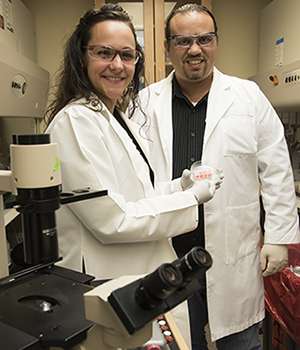Personalized drug screening on horizon for multiple myeloma patients

A personalized method for testing the effectiveness of drugs that treat multiple myeloma may predict quickly and more accurately the best treatments for individual patients with the bone marrow cancer. The process, developed by scientists at Washington University School of Medicine in St. Louis, also may aid patients with leukemia or lymphoma.
The screening method suggests which commonly prescribed multiple myeloma drug, or combination of drugs, a physician should consider first for a particular patient. The test also suggests optimum dosage.
A study validating the new method will be published in the December issue of the journal Biomaterials and now is available online.
The method also is being evaluated in a clinical trial involving patients with multiple myeloma. The results will indicate if the method is more effective than current screening methods.
"Even before the patient completes all of the MRIs, CT scans and other imaging procedures following diagnosis, we can have a recommendation for which drug and dosage to prescribe," said Kareem Azab, PhD, an assistant professor of radiation oncology at the School of Medicine and the Siteman Cancer Center member who leads the research. "The test results come in three to four days."
Multiple myeloma is a cancer of the infection-fighting plasma cells, part of the immune system found mainly in bone marrow. This year, an estimated 26,850 U.S. residents will be diagnosed with the disease and about 11,240 patients are expected to die, according to the American Cancer Society. Half of multiple myeloma patients diagnosed in the earliest stage of the disease don't survive beyond about five years after initial treatment because the cancer becomes resistant to treatments.
Treating multiple myeloma is difficult because in 90 percent of cases there is no obvious genetic mutation that can be targeted with treatment. Also, standard drug screening methods don't adequately re-create the environment surrounding cancer cells growing in a particular patient's body, making those methods less reliable at predicting effective drug therapies.
Azab hopes a more personalized approach will improve long-term patient outcomes. The method relies on 3-D tissue-engineered bone marrow (3DTEBM) cultures that Azab and his colleagues developed using myeloma patients' bone marrow samples. To more closely mimic outside the body what goes on within, scientists take small samples of a patient's cells – cancerous and benign – and remodel them in the lab. This tumor "microenvironment" includes the cancer cells and other neighboring blood vessels, immune cells and other components whose interaction can help or inhibit the tumor cells' growth.
Drugs then are tested on the remodeled patient cells to determine which treatment is likely to be most effective.
Azab's method gauges the sensitivity of a patient's cells to different drugs at any time in the course of the disease. Therefore, as a patient's multiple myeloma becomes more resistant to particular drugs, continued drug screening could suggest when to change therapies. This could save valuable time, he said.
"Now we have a drug test that closely replicates what's going on with a patient at any given moment," Azab said. "We think this method has a better chance of working than existing options."
Azab and his colleagues have launched a company, Cellatrix, in coordination with Washington University's Office of Technology Management and BioGenerator, a nonprofit organization that helps area bioscience companies form.
Others have taken notice of the testing method and its potential. Later this year, Cellatrix will begin testing potential therapies on behalf of pharmaceutical companies. Azab's team also is studying how well the screening method works for patients with leukemia or lymphoma, which are cancers of the blood.
More information: Pilar de la Puente et al. 3D tissue-engineered bone marrow as a novel model to study pathophysiology and drug resistance in multiple myeloma, Biomaterials (2015). DOI: 10.1016/j.biomaterials.2015.09.017













